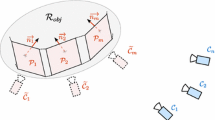Abstract
We consider the problem of tracking n targets in the plane using 2n cameras, where tracking each target requires two distinct cameras. A single camera (modeled as a point) sees a target point in a certain direction, ideally with unlimited precision, and thus two cameras (not collinear with the target) unambiguously determine the position of the target. In reality, due to the imprecision of the cameras, instead of a single viewing direction a target defines only a viewing cone, and so two cameras localize a target only within the intersection of two such cones. In general, the true localization error is a complicated function of the angle subtended by the two cameras at the target (the tracking angle), but a commonly accepted tenet is that an angle of 90° is close to the ideal. In this paper, we consider several algorithmic problems related to this so-called “focus of attention” problem. In particular, we show that the problem of deciding whether each of n given targets can be tracked with 90° is NP-complete. For the special case where the cameras are placed along a single line while the targets are located anywhere in the plane, we show a 2-approximation both for the sum of tracking angles and the bottleneck tracking angle (i.e., the smallest tracking angle) maximization problems (which is a natural goal whenever targets and cameras are far from each other). Lastly, for the uniform placement of cameras along the line, we further improve the result to a PTAS.
Access this chapter
Tax calculation will be finalised at checkout
Purchases are for personal use only
Preview
Unable to display preview. Download preview PDF.
Similar content being viewed by others
References
Hartley, R.I., Zisserman, A.: Multiple View Geometry in Computer Vision, 2nd edn. Cambridge University Press, Cambridge (2004)
Yilmaz, A., Javed, O., Shah, M.: Object tracking: A survey. ACM Computing Surveys 38(4) (December 2006)
Isler, V., Khanna, S., Spletzer, J., Taylor, C.J.: Target tracking with distributed sensors: the focus of attention problem. Computer Vision and Image Understanding 100(1-2), 225–247 (2005)
Spieksma, F.: Multi index assignment problems: complexity, approximation, applications. In: Nonlinear Assignment Problems, pp. 1–12. Kluwer, Dordrecht (2000)
Spieksma, F., Woeginger, G.J.: Geometric three-dimensional assignment problems. European Journal of Operational Research 91, 611–618 (1996)
Goossens, D., Spieksma, F.: On the FOA-problem. Manuscript (January 2004)
Arkin, E.M., Hassin, R.: On local search for weighted k-set packing. Mathematics of Operations Research 23(3), 640–648 (1998)
Gfeller, B., Mihalák, M., Suri, S., Vicari, E., Widmayer, P.: Angle optimization in target tracking. Technical Report 592, Department of Computer Science, ETH Zurich (2008), http://www.inf.ethz.ch/research/disstechreps/techreports
Galil, Z.: Efficient algorithms for finding maximum matching in graphs. ACM Comput. Surv. 18(1), 23–38 (1986)
Author information
Authors and Affiliations
Editor information
Rights and permissions
Copyright information
© 2008 Springer-Verlag Berlin Heidelberg
About this paper
Cite this paper
Gfeller, B., Mihalák, M., Suri, S., Vicari, E., Widmayer, P. (2008). Angle Optimization in Target Tracking. In: Gudmundsson, J. (eds) Algorithm Theory – SWAT 2008. SWAT 2008. Lecture Notes in Computer Science, vol 5124. Springer, Berlin, Heidelberg. https://doi.org/10.1007/978-3-540-69903-3_8
Download citation
DOI: https://doi.org/10.1007/978-3-540-69903-3_8
Publisher Name: Springer, Berlin, Heidelberg
Print ISBN: 978-3-540-69900-2
Online ISBN: 978-3-540-69903-3
eBook Packages: Computer ScienceComputer Science (R0)




